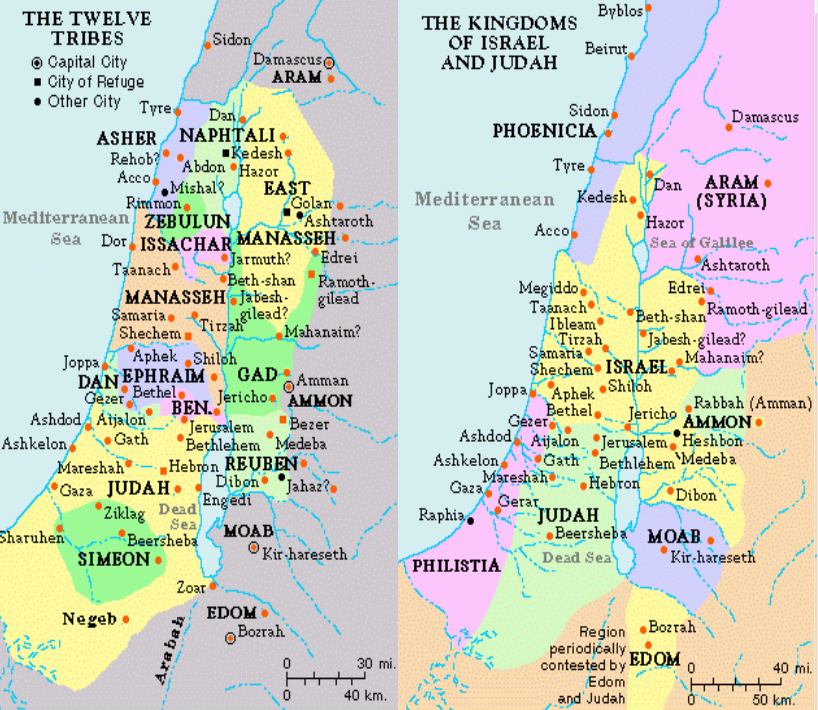1 Chronicles 7
The northern tribes (7:1–40)
1. Issachar (1-6), 2.Benjamin (6-12), 3.Naphtali (13) & Manasseh–west (14-19), 4.Ephraim (20-29), 5.Asher (70-40).
The greatest amount of detail is devoted to Judah, Levi, and Benjamin.
Vs. 20-29: Genealogy of Joshua: Joshua is the famous Ephraimite who became the successor of Moses. The Ephraim in verse 22 is not the son of Joseph, as this incident happened after about 7 generations or more.
1 Chronicles 8
The Tribe of Benjamin: The author mentioned about Benjamin tribe in chapter 7:6-12 to show them in terms of settlement, and with the big picture of the tribes of Israel. But the genealogy of Benjamin is little common with 7:6-12, and is mentioned in chapter 8 for a different purpose.
ESV Study Bible: The structure of Judah-Levi-Benjamin is completed here. The other tribes are enclosed within an ideal conception of Israel as a nation led by the royal tribe of Judah in partnership with its neighbor Benjamin, with Levi at the center to remind the people of their spiritual vocation. Although most of Benjamin sided with the north in the disruption of the kingdom under Rehoboam, the Benjaminite area around Jerusalem as far as Bethel remained loyal to the Davidic king (see 1 Kings 12:21). Judah and Benjamin formed the southern kingdom, and they are regularly mentioned together in this book (2 Chron. 11:1–3, 10; 14:8; 15:2, 9; 31:1). Together they were the legitimate heirs of Israel as it existed under the united monarchy. Judah and Benjamin also formed the core of the postexilic community in Jerusalem and Judah (cf. Ezra 1:5; Neh. 11:4–9).
The first king of Israel is from Benjamin tribe,
Most of the Benjamites who live around Jerusalem and up to Bethel supported Davidic royal line.
They were identified with the name and nation of Judah after division,
They have gone down to Babylon during exile.
Verses 1–28: These descendants in these verses are the ones who live in geographical location of Jerusalem (verse. 6). They would have reminded the Chronicler’s readers of their identity and ancient claim to the land, founded on God’s promise and gift (16:17–18; 2 Chron. 20:7).
1 Chron. 8:1–7 The descendants of the famous judge Ehud (Judg. 3:15).
1 Chron. 8:8–28: These are the descendants of Elpaal, who led a westward expansion into the coastal plain (vv. 12–13) and settled in Jerusalem (v. 28).
Verses 29–40: This genealogy is of the most famous family from Benjamin tribe, Saul the first king of Israel.
Verses 35–38: extends the family line into the late pre-exilic time. These details are not known from other earlier sources, and were preserved among those families that prized the memory of their descent from Israel’s first king.
1 Chronicles 9: The genealogy of Jews Returned from exile in Babylon.
This chapter is the climax to the genealogies, outlining the descendants of those who returned to Judah from the Exile. The roots are traced from Adam down to their present state in Jerusalem after their return from Babylonian Exile. This chapter clearly affirms that 1 & 2 Chronicles are post-exilic work. In this resettlement of Jerusalem, the author concentrates on the priests, the worship personnel.
V. 1a… This talks about the concluding summary of the genealogies of all Israel in Chapters 2-8.
V. 1b…Breach of faith… The southern Kingdom of Judah was exiled because of their unfaithfulness. The reason is parallel to the fate of Northern Kingdom (1 Chronicles 5:25, 26).
Content of Chapter 9:
1. Summarizing conclusion (V.1)
2. Dwellers in Jerusalem (Vs. 2-9)
3. The Priests at Jerusalem (Vs, 10-13)
4. The Levites at Jerusalem (vs. 14-16)
5. The Levite Gatekeeper (Vs. 17-27)
6. Other Levite responsibilities (vs. 28-34)
7. The family of King Saul (Vs. 35-44)
